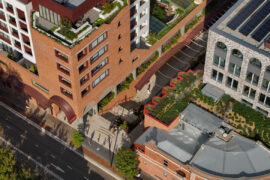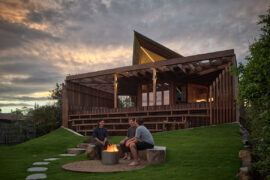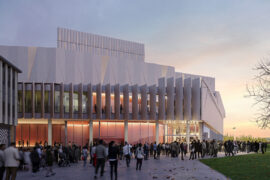At Bodh Gaya in India, SJK Architects has conceived a special place for pilgrims, tourists and locals to enjoy, where hospitality and spirituality coalesce in harmony.

August 1st, 2023
Situated in the north-eastern Indian state of Bihar, the village of Bodh Gaya is considered to be one of the most important and sacred Buddhist pilgrimage destinations in the world. The ancient Mahabodhi Temple Complex was built to mark the site where the Buddha was said to have attained enlightenment beneath a sacred Bodhi tree and hundreds of thousands of pilgrims and tourists from around the globe journey annually to pay homage.
In designing a hotel for this very special place at Bodh Gaya, a certain understanding and sensitivity was required in order to provide great design that would complement and revere the place, culture and religion. As designers of the project, Shimul Javeri Kadri, Vaishali Mangalvedhekar and Roshni Kshirsagar of SJK Architects have created architecture that evokes the power of memory and embodies the tenets of Buddhism.

Covering an area of 7060-square-metres and within easy access of the Mahabodhi Temple, the Hotel at Bodh Gaya combines clean linear form and sophisticated aesthetics with contemporary design and the result is elegant, simple and so very appropriate.
The 78-key hotel consists of two main zones – the public block close to the northern access road and the guest compound at the southern end of the site. These two areas are separated by a linear body of water oriented east-west.
Related: 5 of the best hospitality lighting designs in 2023

The public section comprises reception, a swimming pool and restaurant arranged around a long central courtyard that becomes the heart of the hotel. Evoking the spirit of Buddhism, each space responds to two key architecture ideas, memory and emotion. Memory is represented through traditional features of Buddhist architecture such as vaults, corbelled arches and stepped jambs reminiscent of the past but updated for modern living.
Emotion is conveyed through a series of architectural layers in the form of outdoor, semi-outdoor and indoor spaces that help to gently transition the guest into and through the public section. Portals are formed at the edges of these separate but merging spaces and frame views to provide vignettes of the inside and outside. A banyan tree is positioned at the end of the central courtyard, the same species of tree under which Buddha is said to have received enlightenment.

There is a human scale conveyed through the proportions of the courtyards, verandas, arches and windows, while the landscaping and river-like pool with floating lotus plants creates a serene and tranquil environment.
Ideas from Buddhist philosophy and symbology inform the hotel’s interiors, artwork and signage. The five wisdoms associated with Buddhism, represented in the Buddhist icon of Vajradhatu Mandala, are expressed in the five public spaces – reception, cafe, banquet, lounge and spa-gym-pool. These wisdoms are fearlessness, the wisdom of dharma, giving and sharing, unity with oneself and oneness with the earth.

The mandala associates each wisdom with a mudra, a symbolic hand gesture. Each mudra is further associated with specific colours, seasons, elements and symbols, which are translated into interior design schemes for the spaces.
For example, the spa-gym-pool represents oneness with the earth and is associated with the colour blue used in all the internal walls of the space. There is also the connection to the season of winter and this is represented through a motif of a bare tree on one wall and an abstract wall pattern on the other. The association with water is conveyed through the pool and another abstracted motif denotes the element of water in the signage of the space.

The minimal colour palette of cream and warm terracotta, both delineates and defines spaces and the materiality is local and authentic.
When it comes to construction, brick is used extensively in the region. However, the architects found that sandy soil on site with a poor bearing capacity made that prohibitive. Hence, a combination of Reinforced Cement Concrete, Autoclaved Aerated Concrete (AAC) blocks and bricks were used to ensure structural soundness.

The roof has been constructed using locally-made tiles called ‘country tiles’. While this style of tile has virtually disappeared in other parts of India, the architects collaborated with some 26 local families in 12 villages who handcrafted the 80,000 clay tiles required.
These half-round clay tiles are created, with skill, on a potter’s wheel to form cylinders that are then cut and fired into half-rounds. The material is not only appropriate to the design intention but also helped support and include the local populace in the project.

Several passive design strategies are integrated into the design and these reduce energy consumption and create thermal comfort. Orientation of the two blocks of the hotel minimise heat gain in summer and aerated concrete blocks, double-glazing and a double roof system topped with the clay tiles provides insulation.
Courtyards introduce natural ventilation and a water management system helps sustain the hotel and landscape.

Hotel at Bodh Gaya is exemplary in its concept and layering of meaning. It sits beautifully in the landscape and has become a new modern destination in the most spiritual and historic of places. SJK Architects is to be congratulated for such an inspirational project that is so finely tuned in its architecture that brings people and place together.
Roshni Kshirsagar, partner, SJK Architects, is a member of the 2023 INDE.Awards jury. Register here to watch the 2023 Gala live, and find out who takes home INDE Gold on 10 August 2023.
SJK Architects
sjkarchitects.com
Photography
Niveditaa Gupta






We think you might also like this story on Boat Club Apartments in Chennai by SJK Architects.
INDESIGN is on instagram
Follow @indesignlive
A searchable and comprehensive guide for specifying leading products and their suppliers
Keep up to date with the latest and greatest from our industry BFF's!

Welcomed to the Australian design scene in 2024, Kokuyo is set to redefine collaboration, bringing its unique blend of colour and function to individuals and corporations, designed to be used Any Way!

The undeniable thread connecting Herman Miller and Knoll’s design legacies across the decades now finds its profound physical embodiment at MillerKnoll’s new Design Yard Archives.

Seven years in the making, the new Surry Hills Village is here with doors open and crowds gathering.

With its latest outpost inside Shanghai’s bustling Hongqiao International Airport, HARMAY once again partners with AIM Architecture to reimagine retail through colour, movement and cultural expression.
The internet never sleeps! Here's the stuff you might have missed

Recognised as a winner at the INDE.Awards 2025, Barton Taylor has received The Photographer – Residential accolade. His photographic work on Cake House captures the soul of a coastal icon reimagined, blending light, texture and atmosphere into a compelling visual narrative.

COX Architecture and Yerrabingin reveal the design for Canberra Lyric Theatre — a world-class, inclusive venue for the nation’s capital.